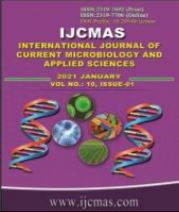


 National Academy of Agricultural Sciences (NAAS)
National Academy of Agricultural Sciences (NAAS)

|
PRINT ISSN : 2319-7692
Online ISSN : 2319-7706 Issues : 12 per year Publisher : Excellent Publishers Email : editorijcmas@gmail.com / submit@ijcmas.com Editor-in-chief: Dr.M.Prakash Index Copernicus ICV 2018: 95.39 NAAS RATING 2020: 5.38 |
Paddy straw and press mud are agricultural and industrial wastes, which are generated in rice fields and sugar mill respectively. The disposal of these wastes into land or water is great environment hazard. So, co-composting could be considered as a feasible and safe method to recycle and transform them into organic manures which can be used in agricultural soil. So, the present investigation was planned with the objectives to co-compost paddy straw and pressmud using microbial consortia. Co-composting of paddy straw and pressmud in different ratio was carried out in pits by adjusting initial C/N ratio to 50:1. Total organic carbon in different treatments decreased due to losses of C and total N increased due to accumulation of nitrogen upto 90 days. Ammoniacal nitrogen decreased with time during composting in all the treatments. Amount of nitrate-nitrogen increased significantly and varied from 180 mg/kg to 527 mg/kg. The C: N ratio declined from 59.95 and 33.89 to 33.75 and 22.45 in controls (T1 and T2) respectively, after 90 days of composting and treatment T6 had minimum C/N ratio (15.51). Amount of total phosphorous varied from 185 to 1035 mg/kg. Total potassium increased from 0.89 to 1.53 % and 0.72 % to 1.02% in controls.
 |
 |
 |
 |
 |